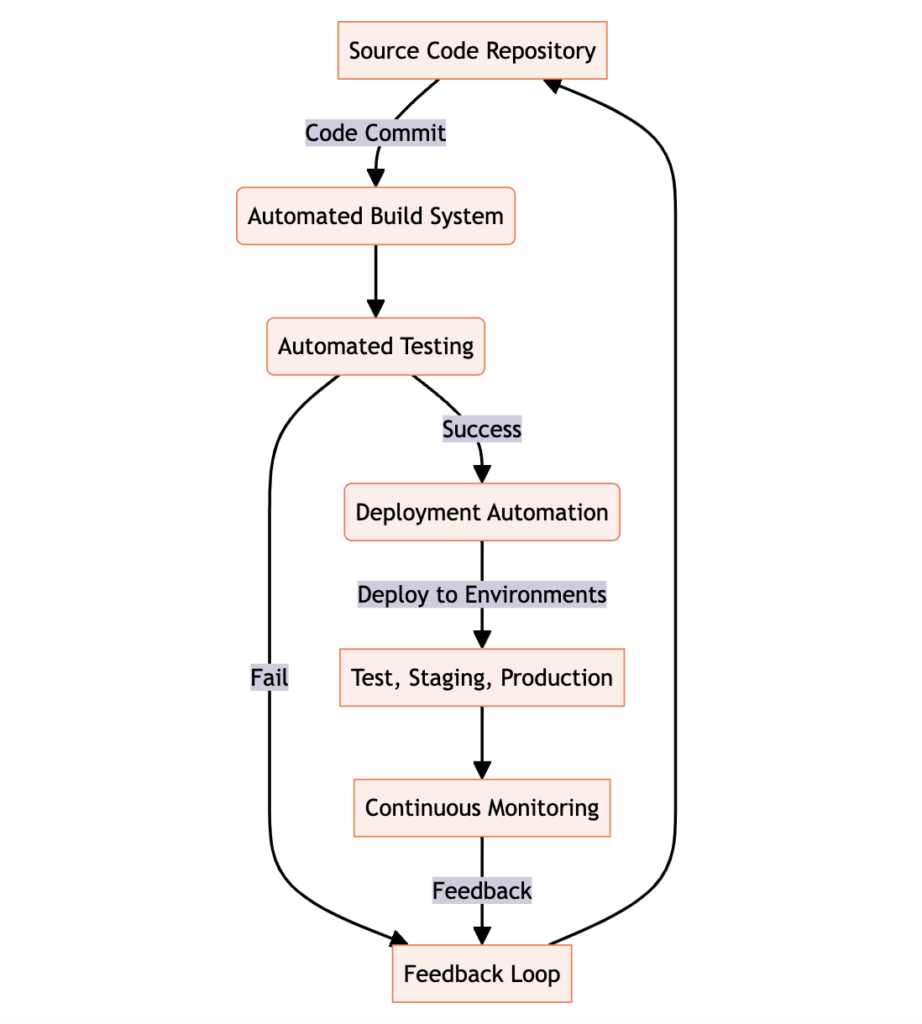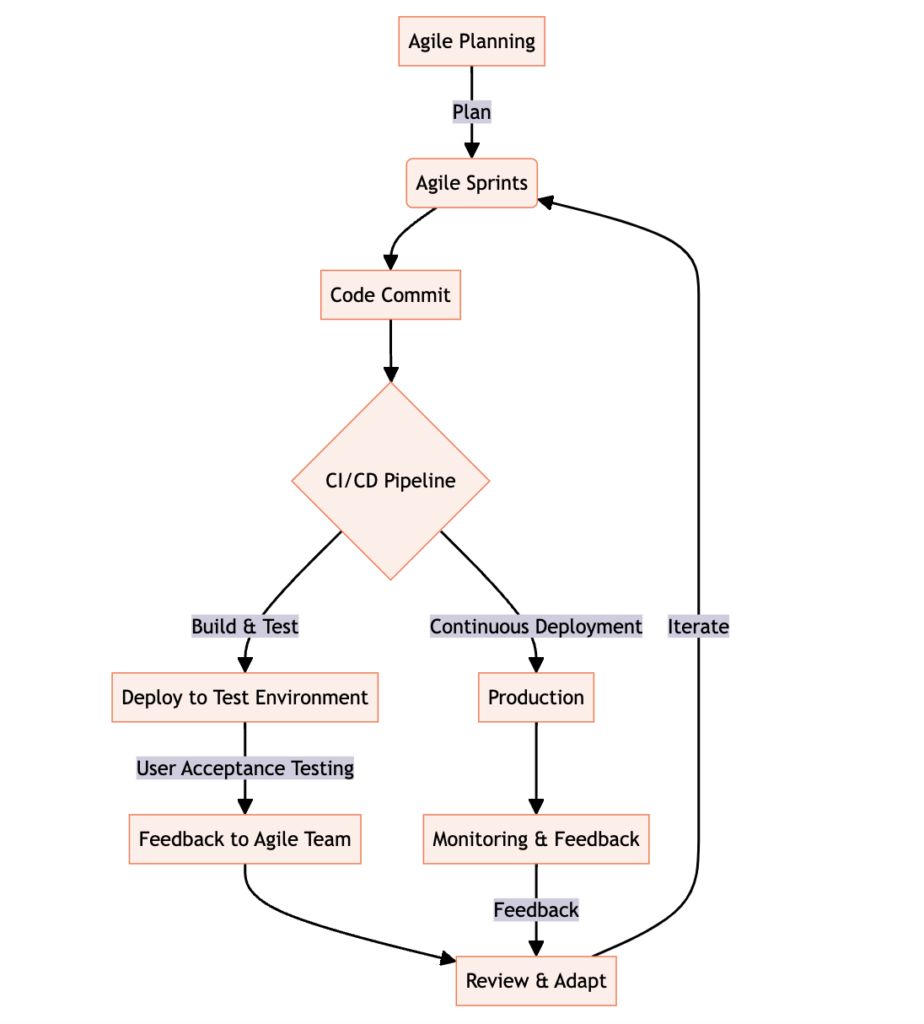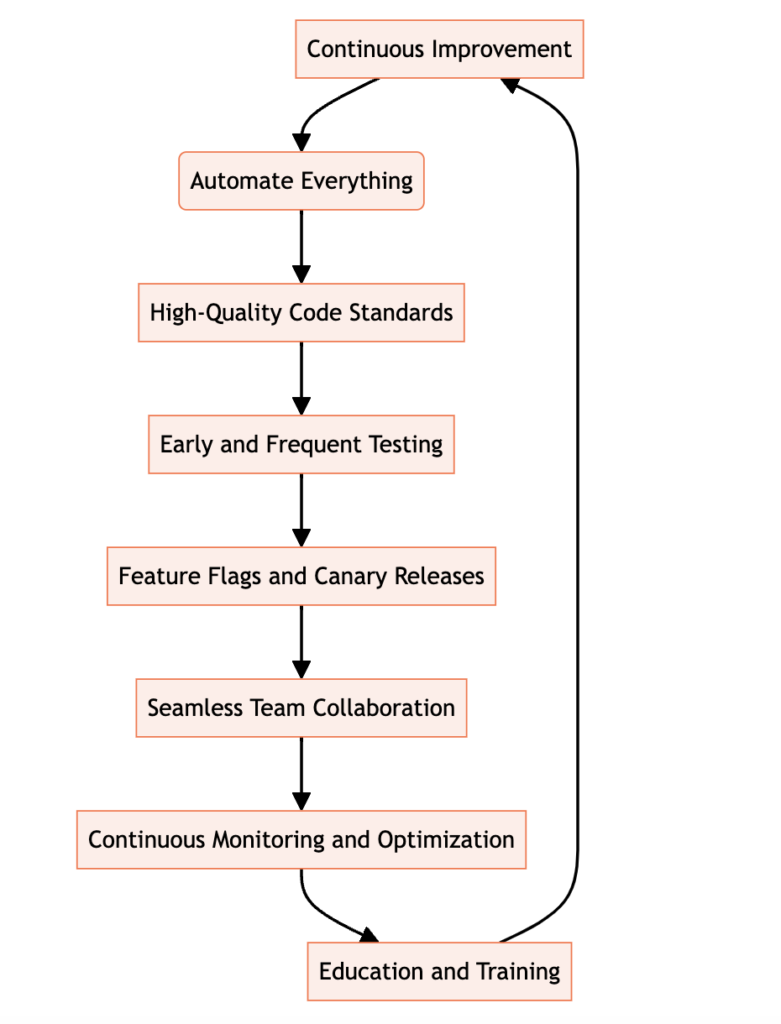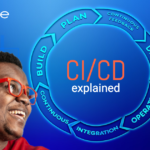CI/CD integration has become an essential practice in the software development industry. It refers to the continuous integration and continuous delivery or deployment of code changes. This process allows developers to merge their code changes into a shared repository frequently and automatically build and test the changes. Here’s why CI/CD integration is crucial for software development and quality assurance.
Continues Integration Meets Continues Deployment
CI/CD: The Dynamic Duo CI/CD is all about making software development smoother and more efficient. Continuous Integration is the practice of frequently merging code changes into a central repository, where automated tests run. This means developers get immediate feedback on their work, catching and fixing issues early on. Continuous Deployment takes things a step further, automatically deploying all code changes to a testing or production environment after the build stage. This seamless flow ensures that software is always in a state of readiness to be released, speeding up the delivery process without sacrificing quality.

Why CI/CD Matters for Quality Assurance
Quality Assurance isn’t just about finding bugs; it’s about delivering a great product that meets user needs and expectations. CI/CD supports this by:
- Reducing Errors: By automating testing, CI/CD catches bugs early when they’re easier (and cheaper) to fix.
- Saving Time: Developers spend less time on manual testing and fixing late-discovered errors, meaning more time for feature development.
- Improving Product Quality: Regular, automated testing ensures a higher overall quality of the software product.
- Enhancing Team Morale: Developers can focus on what they do best — creating great software, while automated processes handle the repetitive tasks.
In essence, CI/CD creates a feedback loop that’s fast and effective, ensuring that quality is built into the product from the ground up. It’s like having a safety net that catches issues before they
Key Components of CI/CD in Software Development
Understanding the machinery behind Continuous Integration and Continuous Deployment (CI/CD) can seem daunting at first glance. Yet, when broken down, it’s clear how each part plays a pivotal role in streamlining the software development lifecycle. Here’s a breakdown of the essential components:

1. Source Code Repository
Everything starts with the source code repository, a storage hub (like GitHub or Bitbucket) where developers commit changes. It’s the foundation of the CI/CD process, enabling version control and collaboration. Whenever a developer pushes new code, the CI/CD pipeline springs into action.
2. Automated Build System
Once code is committed, the automated build system takes over. It compiles the code into a runnable application or software package, ensuring that the latest changes don’t break the build. This stage is crucial for catching errors early and often.
3. Automated Testing
Perhaps the most critical component, automated testing, involves running various tests (unit, integration, system, and more) without manual intervention. It’s here that the quality of the software begins to take shape, with issues identified and addressed swiftly.
4. Deployment Automation
After testing, deployment automation comes into play. This involves moving the tested software to different environments (testing, staging, production). It ensures that the software is deployable at any moment, facilitating continuous delivery or deployment.
5. Continuous Feedback and Monitoring
The final piece of the puzzle is continuous feedback and monitoring. Tools and practices here ensure that any post-deployment issues are quickly identified and resolved. This feedback loop is vital for maintaining software quality over time and informs future development cycles.
Would you like to get engaged with professional Specialists?
We are a software development team with extensive development experience in the Hybrid and Crossplatform Applications development space. Let’s discuss your needs and requirements to find your best fit.
The Synergy of CI/CD Components
When these components work together, they create a robust ecosystem that supports rapid development, testing, and deployment. The synergy between them not only speeds up the delivery of new features but also enhances the reliability and quality of the software. By automating these processes, teams can focus on innovation and improvement, knowing that their CI/CD pipeline handles the heavy lifting of software delivery.
How CI/CD and Agile Methodology Revolutionize Quality Assurance
The integration of Continuous Integration and Continuous Deployment (CI/CD) within Agile software development practices marks a significant leap forward in quality assurance (QA). This powerful combination not only streamlines development processes but also redefines the approach to maintaining quality throughout the lifecycle of software creation.

Agile Foundations Meet CI/CD Automation
Agile methodology prioritizes adaptability, continuous feedback, and customer satisfaction, ideals that are perfectly complemented by CI/CD’s automation and efficiency. CI/CD pipelines bring Agile principles to life by facilitating rapid iterations and ensuring that new features are automatically tested and ready for deployment. This synergy enhances the Agile commitment to delivering high-quality software at a faster pace.
Continuous Testing: The Heart of Agile QA
In the Agile framework, testing is an ongoing activity that ensures quality evolves alongside the product. CI/CD amplifies this by integrating automated testing directly into the development cycle, allowing for immediate detection and correction of issues. This continuous testing foundation is key to Agile’s ability to adapt and refine quickly based on feedback, ensuring that quality is built into the product from the start.
Accelerating Agile Feedback Loops with CI/CD
The iterative nature of Agile development benefits immensely from CI/CD’s rapid feedback loops. With automated deployments, stakeholders and users can quickly access the latest versions of the software, providing valuable feedback that informs subsequent iterations. This fast-paced cycle of feedback and improvement is crucial for aligning the software with user needs and market demands while upholding quality standards.
Boosting Agile Team Dynamics
CI/CD supports Agile’s emphasis on collaboration and transparency by automating the build and deployment processes. This removes silos between development, QA, and operations teams, fostering a unified approach to quality assurance. With CI/CD, the entire team gains visibility into the development process, enhancing communication and joint accountability for the product’s quality.
Agile Quality in a CI/CD World
Adopting CI/CD within an Agile framework empowers teams to deliver software that is not only functional and reliable but also continuously aligned with customer expectations. This approach ensures that quality assurance is not just a checkpoint but an integral part of the development process, resulting in products that truly meet the agile goal of satisfying the customer through early and continuous delivery of valuable software.
Dedicated Full Stack Developers
Hiring Full Stack developers gives businesses access to pros proficient in various technologies and frameworks. Their versatility streamlines collaboration, leading to faster development and enhanced efficiency.
Best Practices for Integrating CI/CD in Quality Assurance Strategies
Integrating Continuous Integration/Continuous Deployment (CI/CD) into quality assurance (QA) strategies is a transformative step that can significantly improve software development processes. Here are key best practices to ensure a smooth integration:

1. Embrace a Culture of Continuous Improvement
- Foster an organizational culture that values continuous learning and improvement. Encourage teams to regularly review and optimize CI/CD and QA processes.
- Celebrate successes and view failures as opportunities for growth and improvement.
2. Automate Wherever Possible
- Automate repetitive tasks within the CI/CD pipeline, including code integration, testing, and deployment. This reduces manual errors and frees up teams to focus on more complex issues.
- Ensure that automated tests cover as much of the codebase as possible and are updated regularly to reflect new features and bug fixes.
3. Maintain High-Quality Code Standards
- Implement coding standards and conduct regular code reviews to maintain high-quality code that integrates smoothly into the CI/CD pipeline.
- Utilize static code analysis tools to automatically identify potential issues before they enter the pipeline.
4. Prioritize Early and Frequent Testing
- Integrate testing early in the development cycle to detect and resolve issues sooner, reducing the cost and effort required for fixes.
- Use a variety of testing types, including unit, integration, and end-to-end tests, to ensure comprehensive coverage.
5. Leverage Feature Flags and Canary Releases
- Use feature flags to enable or disable features without deploying new code, allowing for easier testing and rollback.
- Implement canary releases to gradually deploy changes to a small subset of users before a full rollout, minimizing the impact of potential issues.
6. Ensure Seamless Collaboration Across Teams
- Promote open communication and collaboration between development, QA, and operations teams to ensure everyone is aligned on the goals and processes of the CI/CD pipeline.
- Use collaborative tools and platforms that support visibility into the pipeline’s status and progress.
7. Continuously Monitor and Optimize the Pipeline
- Implement monitoring and logging tools to track the performance and health of applications post-deployment.
- Regularly review the CI/CD pipeline for bottlenecks or inefficiencies and refine processes accordingly.
8. Educate and Train Your Teams
- Provide ongoing training and resources for teams to stay updated on the latest CI/CD and QA methodologies and tools.
- Encourage knowledge sharing sessions and workshops to foster a learning environment.
Custom Real-World Use Cases of CI/CD in Quality Assurance
The integration of Continuous Integration and Continuous Deployment (CI/CD) into quality assurance (QA) has been transformative across multiple industries. Here are a few standout examples that illustrate the impact of CI/CD on improving software quality and development processes.
1. E-Commerce: Streamlined Product Updates
- An e-commerce giant implemented CI/CD to manage its vast online storefront, enabling them to push updates multiple times a day with minimal downtime. Automated testing in their CI/CD pipeline ensured that new features and fixes did not disrupt the shopping experience, leading to increased customer satisfaction and sales.
2. Financial Services: Enhanced Security and Compliance
- A leading bank utilized CI/CD to automate compliance checks and security testing as part of their QA process. This proactive approach not only streamlined deployments but also significantly reduced the risk of security breaches, protecting sensitive customer data.
3. Healthcare: Improving Patient Care Software
- In the healthcare sector, a software provider for patient care systems adopted CI/CD to accelerate the delivery of critical updates to their platforms. Automated testing ensured high quality and reliability, crucial for medical software where errors can have serious implications.
4. Gaming: Faster Release Cycles
- A popular gaming company integrated CI/CD to speed up the release of new game updates and patches. This allowed for rapid iteration based on player feedback, improving game quality and player engagement without sacrificing stability.
5. Education: Continuous Learning Platforms
- An online education platform used CI/CD to regularly update its course content and features. Automated QA processes ensured that updates were seamless, enhancing the learning experience for users worldwide without disrupting ongoing courses.
6. Startups: Agile Development from Day One
- Many startups adopt CI/CD early in their development lifecycle to maintain a competitive edge. For instance, a tech startup focusing on renewable energy solutions implemented CI/CD to ensure that their software could reliably scale with their growing user base, while maintaining the agility to adapt quickly to market demands.
7. Government: Streamlining Public Services
- A government agency transformed its digital services through CI/CD, automating their QA processes to improve the reliability and accessibility of online public services. This shift not only improved citizen satisfaction but also enhanced operational efficiency.
These examples showcase the versatility and impact of CI/CD across different sectors, proving that when integrated effectively with QA strategies, CI/CD can drive significant improvements in software quality, security, and user satisfaction.
List of Most Popular CI/CD Tools
| Tool Name | Description |
|---|---|
| Jenkins | An open-source automation server that enables developers to build, test, and deploy their applications. |
| CircleCI | A CI/CD tool that automates the software development process, from code building, testing, to deployment. |
| Travis CI | A cloud-based CI service that automatically builds and tests code changes, facilitating more streamlined code integration. |
| GitLab CI/CD | A part of GitLab, offering powerful CI/CD features directly integrated into the GitLab workflow for software development and deployment. |
| GitHub Actions | Enables the automation of workflows directly in your GitHub repository, supporting CI/CD and much more. |
| Bamboo | A CI/CD server solution from Atlassian that offers build and deployment automation for continuous delivery. |
| GitLab CI | Integrated into GitLab, it provides a streamlined approach to automate the build, test, and deploy phases of your application. |
| Azure DevOps | Offers a range of services including CI/CD, testing, and release management to support a DevOps approach. |
| JFrog Artifactory | A universal artifact repository manager that integrates with CI/CD pipelines to improve efficiency and control. |
| Selenium | A portable framework for testing web applications, widely used for automated testing in CI/CD processes. |
Integrating CI/CD with QA strategies requires commitment and ongoing effort, but the payoff in enhanced efficiency, reduced errors, and improved product quality is well worth it. By following these best practices, organizations can leverage CI/CD to its full potential, transforming their software development and QA processes.






